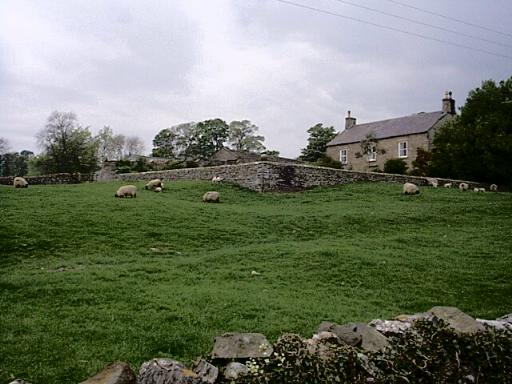
Torchil de Bovington
 |
When the comparative advantage of your land is stone fences you know life is not going to be easy. That is what Agglethorpe is like, and sheep is about the best you can do. This is the story of Torchil's downfall -- from Boynton and other good agricultural manors to Agglethorpe.
William showed up in England one day in 1066. Meeting little opposition, he declared: it's all mine! And for twenty years he made good that declaration. He took the land. He gave it to his friends and allies -- to hold from him. An entirely new group of persons became the leading figures in economy and public affairs; Paul Dalton (1994) traced the extent of the transformation in Yorkshire.
Torchil is the first Boynton we know about. He had been lord of the manor at Boynton in 1066, but that ended with William. Torchil was conquered. He did not lose his head, which was the fate of many of his compatriots, but his finances took a nose dive.
Then William did something quite remarkable. He took a census. Conquest was, and is, not remarkable, but taking a census that permits tracing the transformation from before to after the conquest is. It is called The Domesday Book, and it is the oldest census in the western world. It was an economic census -- who held the land in 1066 and who holds it now, twenty years and a revolution later.
The Domesday book tells how much Torchil had and how much he lost. Torchil had more than 60 manors that he held either alone or in conjunction with others. Almost all of the 60 manors were in Yorkshire, but they were scattered across the county. It is only in the second half of the 17th century that the Boyntons began to consolidate their land holdings. Before the 17th century they moved frequently from one manor to another. Second, partnerships in land holding were prevalent in 1066 and they continued to be an important mode of economic organization for a number of centuries. There are many deeds in which a Boynton and three or four others jointly make a deal with an equal number of persons about a single plot of ground.
We have two listings of Torchil's holdings. One is from the translation of the Domesday Book for Yorkshire. It is a bit spare with details. The second is not as complete, but it gives more details. The second list is from the Victoria County Histories for Yorkshire that were written at the end of the 19th and beginning of the 20th centuries.
| Domesday Book |
We do not know how Torchil accumulated his wealth. We do know how he lost it. After the conquest he was left with only a couple of manors -- Agglethorpe, was to be his final fortune [Agglethorpe]. And then he disappeared. He is not listed in Domesday Descendants, which is the most thorough work tracing the persons listed in Domesday through the next century. [K.S.B. Keats-Rohan, 2002]
References
Keats-Rohan, K. S. B. (2002) Domesday Descendants A Prosopography
of Pesons Occurring in English Documents 1066-1166 II. Pipe Rolls to Cartae
Baronum, The Boydell Press.